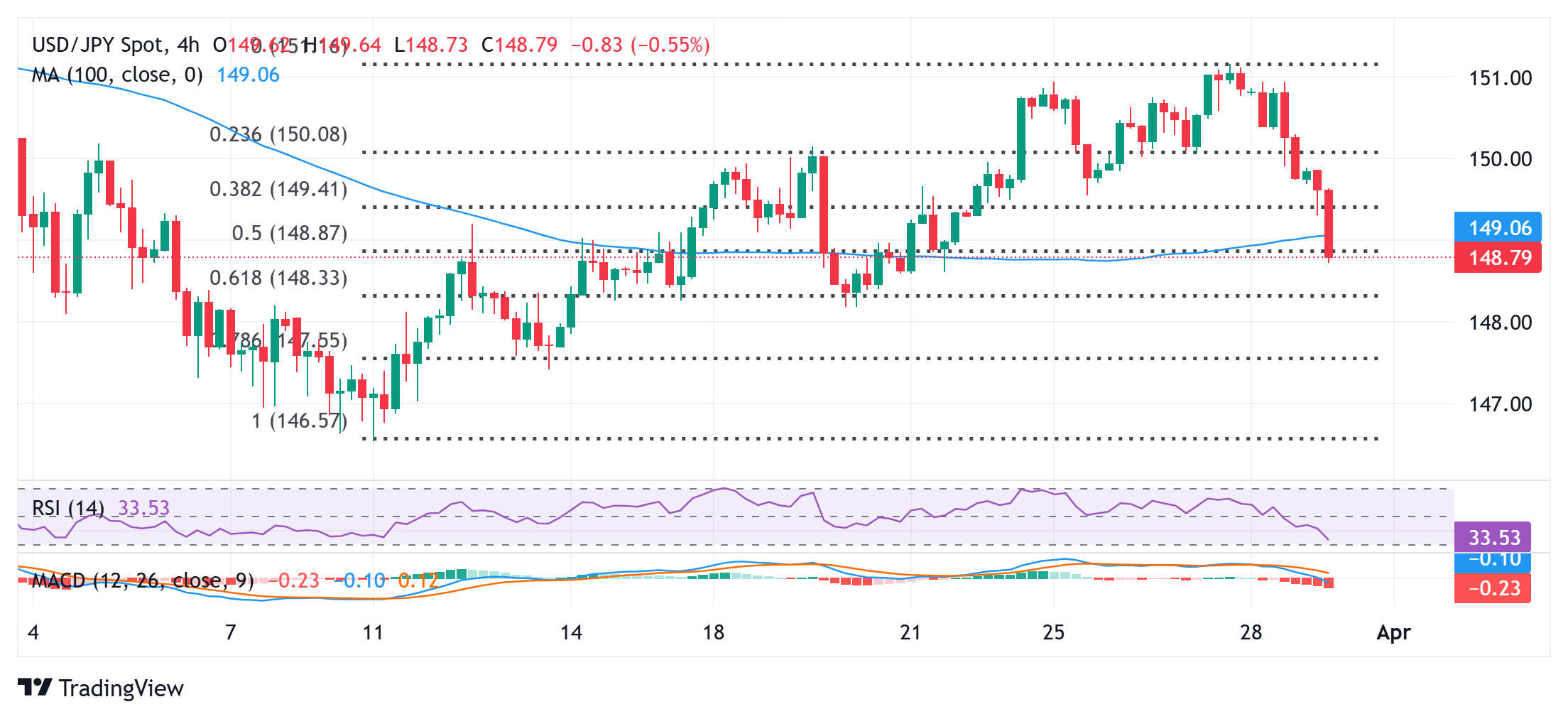-
The Japanese Yen extends Friday’s strong rebound from a multi-week low against the USD.
-
Rising BoJ rate hike expectations and a risk-off sentiment support the safe-haven JPY.
-
Recession concerns drag down the USD, adding further pressure on USD/JPY.
The Japanese Yen (JPY) continues its strong upward momentum for the second consecutive day on Monday, reaching a more than one-week high against a weakening US Dollar (USD) in the early European session. Market uncertainty surrounding US President Donald Trump’s upcoming reciprocal tariffs set to take effect on April 2, coupled with persistent geopolitical tensions, is weighing on investor sentiment and driving safe-haven flows toward the JPY.
Furthermore, growing expectations that the Bank of Japan (BoJ) will continue its rate-hiking cycle, reinforced by Friday’s robust consumer inflation data from Tokyo, provide additional support for the Yen. In contrast, speculation that the Federal Reserve (Fed) will soon resume its rate cuts highlights a stark policy divergence, increasing the likelihood of further JPY appreciation.
Japanese Yen Strengthens Amid Trade Concerns and Rising BoJ Rate Hike Expectations
- US President Donald Trump unsettled global markets last week by announcing a 25% tariff on all non-American cars. Over the weekend, reports emerged suggesting that the Trump administration is considering additional tariffs on a broader range of countries starting April 2. These developments, coupled with mounting concerns over slowing global economic growth, are further deteriorating investor sentiment, prompting a flight to safe-haven assets like the Japanese Yen.
- On Sunday, Trump expressed frustration with Russian President Vladimir Putin and warned of potential secondary tariffs of 25% to 50% on Russian oil buyers should Moscow obstruct his efforts to end the Ukraine war. Additionally, he cautioned Ukrainian President Volodymyr Zelenskiy against reneging on a critical rare-earth minerals deal, stating that such a move would lead to serious consequences.
- Friday’s economic data revealed that consumer inflation in Tokyo remained above the BoJ’s 2% annual target, reinforcing the case for additional rate hikes. The BoJ’s Summary of Opinions from its March meeting underscored a collective inclination toward further tightening should economic and inflationary conditions align with projections, maintaining expectations for continued monetary policy tightening.
- In the US, the Commerce Department reported that the Personal Consumption Expenditures (PCE) Price Index increased by 0.3% in February and 2.5% year-over-year, both aligning with market expectations. However, the core PCE Price Index, which excludes volatile food and energy prices, surged 0.4% for the month, marking its most significant monthly rise since January 2024 and pushing the 12-month inflation rate to 2.8%.
- Additional US data indicated that consumer spending rose 0.4% in February, following a downwardly revised 0.3% decline in January, while personal income climbed 0.8% for the month. Meanwhile, a University of Michigan survey showed that consumers' 12-month inflation expectations reached their highest level in nearly two and a half years, fueling stagflation concerns and weighing on the US Dollar.
- China’s official Purchasing Managers' Index (PMI) data, released by the National Bureau of Statistics (NBS), had a minimal impact on the markets. The Manufacturing PMI edged up to 50.5 in March from 50.2 in February, while the Non-Manufacturing PMI increased to 50.8 from 50.4.
- Japanese Finance Minister Katsunobu Kato stated on Monday that Japan and the US share concerns about excessive foreign exchange movements. However, this did little to dampen the JPY’s bullish momentum, with the USD/JPY pair dropping to the 149.00 level. Investors now turn their focus to this week’s critical US macroeconomic data releases, particularly the Nonfarm Payrolls (NFP) report, for further market direction.
USD/JPY Technical Outlook: Downside Momentum Builds Below Key 149.00 Level

From a technical standpoint, the 149.00 level represents a key support area, aligning with the 100-day Simple Moving Average (SMA) on the 4-hour chart and the 50% Fibonacci retracement level of the recent rally. With momentum indicators on both the hourly and daily charts leaning bearish, a decisive break below this level could trigger further downside pressure, potentially driving the USD/JPY pair toward the 61.8% Fibonacci retracement level at 148.35. A deeper decline could see the pair test the 148.00 psychological support and the next significant level at 147.70.
On the upside, immediate resistance is seen at the 38.2% Fibonacci retracement level near 149.45. A sustained recovery above this level could spark short-covering, allowing the USD/JPY pair to challenge the 150.00 psychological barrier. A break above this resistance would signal the end of the recent corrective pullback, paving the way for further gains toward the 150.60-150.65 region, with the next major target at 151.00 and a potential retest of the monthly high near 151.30.





